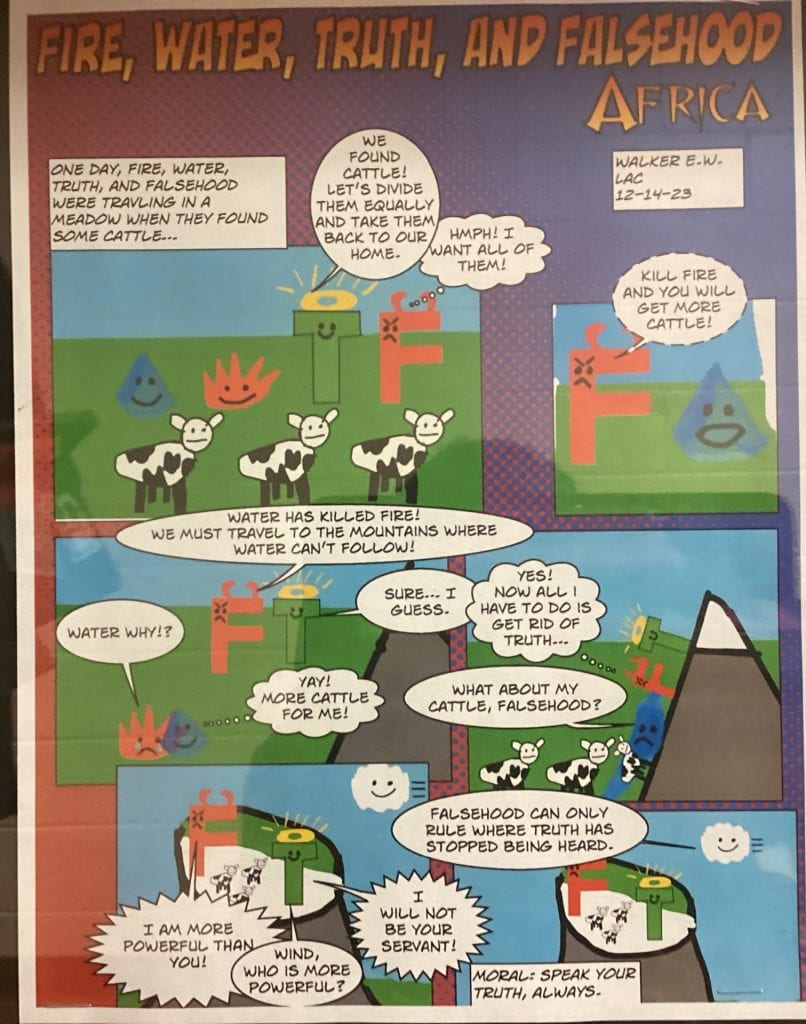
After 3 months of preparation, my Wisdom Tales comic is finally complete. But what was the preparation and what exactly are Wisdom Tales? Well, Wisdom Tales are stories with a moral, and often are fables or myths. To prepare for it, sometime in the middle of September, the Language Arts classes created a new slide called Wisdom Tales From Around the World and started typing out stories. In the Books app, we downloaded a book called Wisdom Tales, and read the stories in it. Then, we went back to our slides and came up with a moral for the story, and a short summary. Eventually, around the middle of December, we all chose a story that we had done and made a one page comic retelling that story. At first, I was worried about this project because I can’t draw, but we had a guest come in and teach us a few tips. His name was Brittain Peck. Brittain Peck is a visual storyteller and he came to Durham Academy to teach us about drawing. He gave a lot of tips, but here are what I feel like his most important three:
- Change the color.
By using color, you can make an object seem sad, by turning it blue, or make it seem mad, by turning it red.
- Change the size.
If you make an object bigger, it can seem like it is shouting, or demanding something. If you make it small, it seems like that object has shrunk.
- All objects are made up of simple shapes.
This is very important. If you are trying to draw a complex object, don’t worry about drawing every single detail, just break it up into squares, circles, and triangles.
After Brittain Peck talked to us, we went back to our classroom and picked a story. I chose Fire, Water, Truth, and Falsehood because it was easy to draw and I already had some ideas on how to draw it. This story is about four friends, Fire, Water, Truth, and Falsehood, who all live in a cabin together. They one day decide to go hunting and find some cattle. For the rest of the story, check out the picture accompanying this blog post. The moral of this story is to ‘Speak your truth, always.’ This means to always tell the truth.
For this project, I used two tools. They were Comic Life 3 and Sketchbook. I am going to share some tips for using both of them.
For Comic Life 3:
- Know how to use everything you are working with.
Comic Life 3 can be a confusing tool, but if you know how to use it, it can be fun. To do this, open the app, and click the wrench in the top right corner. That will display a drop down menu, and from there, click ‘Go to Help’. There you will find guides on how to do everything basic in Comic Life 3.
- You need less space than you think.
For example, I thought I was going to need 10 or 11 panels, but I ended up only using 6.
For Sketchbook:
- Almost always use Fountain Pen.
For this project, I found it incredibly helpful to use this tool. It has a consistent size and has solid colors that look amazing.
- Know how to copy and paste.
This was very helpful in getting my characters to look the same in every picture. All you have to do is click the Lasso button in the top menu, lasso the object, then click on the layer the object is on using the right menu. Press copy, then paste the object on another sketch.
- Take advantage of layers.
There are so many things you can do with layers. You can use them to put your characters exactly where you want them, copy and paste without taking some of the background along with it, or just take out a part you don’t want. That is just getting started. If you can learn to use layers, it opens up so much more in Sketchbook.
Overall, this has been a great experience, and I think it really helped with my drawing.